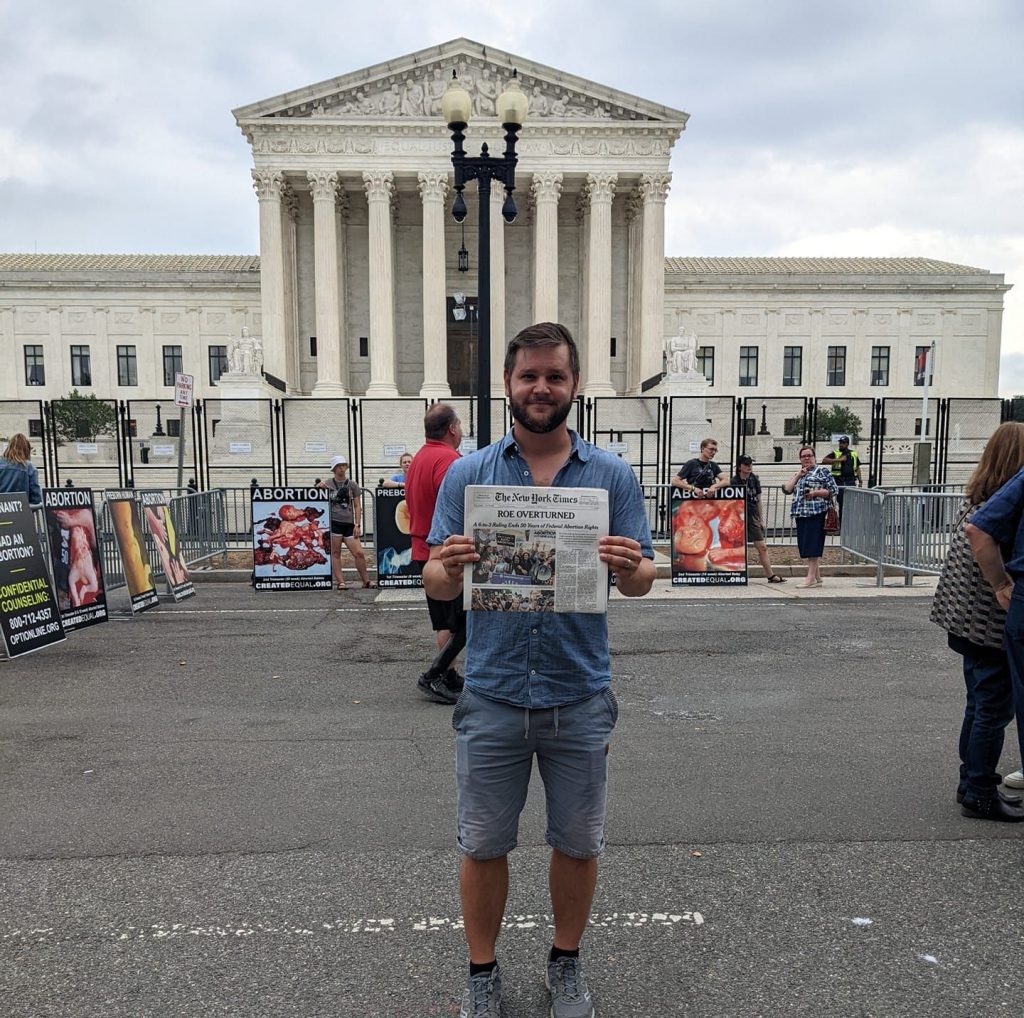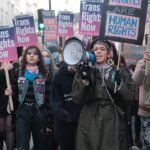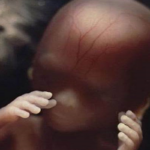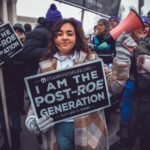Blog Post
Welcome to Post-Roe America
By Jonathon Van Maren
I arrived at the Supreme Court of the United States on June 25, 2022, where the corpse of Roe v. Wade was still fresh. It was warm and muggy, and the angry protestors gathered were shiny in the streetlight glow. There were hundreds of them. One abortion activist with a bullhorn stood in front of the high fence surrounding the Court, bellowing her rage to the seething crowd. Chants of “F*** the court! F*** the court!” rose up, with intermittent chants of “My body, my choice!” and “F*** the police!” The signs—many of them preprinted in anticipation of the ruling—featured slogans like “Overturn Roe? Hell No!”, “Abort the Court!” and plenty of placards that read “I will aid and abet abortion.”
Like most, I had expected the Dobbs ruling to come down on Monday so protestors wouldn’t have the weekend to riot and the justices could get safely out of town. I was just about to give a presentation on the history of the pro-life movement to a group in Montreal when I heard, and I left for Washington D.C. the following day to join pro-life leaders and to speak to activists at the Leadership Institute. It was surreal driving in with my phone dinging with emails: abortions cancelled in Alabama; trigger laws kicking in across the U.S.; ecstatic press releases from pro-life groups calling for the next steps. I talked to several of my pro-life friends on the way. Most had broken down in tears when they heard the news.
I headed to the Court after my speech, and the protests that had raged since the previous day were still going strong. Mark Harrington of Created Equal met me there. Most of the protestors didn’t seem to know what to do besides vent. One activist gave advice to the crowd on getting VPNs to hide geolocation on smart devices and how to induce a miscarriage; another gave directions on how to procure abortion pills in states where it would be illegal. There were a lot of same-sex couples present; the triumphalism of Pride Month is gone. Abortion is the sacrament of the sexual revolution, and the Supreme Court just struck the industry its worst blow in a half-century. A couple of black-masked Antifa members skulked about the fringes, but none made a move.
The leader with the bullhorn asked if anyone wanted to speak, and after several rousing and profane chants, a young man came up and said: “I wish abortion had been overturned earlier.” A brawl broke out instantly, and Capitol police bolted into the fray, jerked him out, and arrested one of the assailants. A mob formed around the police chanting “let him go!” and broke off from the crowd to follow the cops down the street. Besides scuffles, however, the violence promised by groups like Jane’s Revenge and the promised “Night of Rage” have yet to materialize. So far, more pro-life facilities were attacked before Roe fell than after, although crisis pregnancy centers in Colorado and Oregon were targeted with fire, smoke bombs, and paint over the weekend. One DC protestor climbed the Frederick Douglass Bridge, unfurled a green abortion rights banner, and refused to come down for 28 hours.
On Monday morning a thanksgiving prayer service started early in front of the Court as pro-life activists from Created Equal, Survivors of the Abortion, Live Action, and the Progressive Anti-Abortion Uprising (PAUU—the group that recently publicized the killing of late-term babies at Cesare Santangelo’s clinic) showed up. Only a handful of abortion protestors trickled in halfway through the morning. A handful of unproductive shouting matches unfolded, and the Capitol police lurked close to hand. State legislators from Texas and Alabama turned up to mingle with the pro-lifers and talk strategy, but no Democrats made an appearance after Alexandra Ocasio-Cortez’s Saturday bullhorn bellowing about the Court’s illegitimacy and Maxine Waters’ shouting “to hell with the Supreme Court!” As one wag noted, the Democrats took a brief break from the January 6 hearings to foment insurrection.
That night, a post-Roe party was held by several pro-groups at the Leadership Institute, and teary toasts were made to those pro-life leaders who died before Roe did. Some veterans made an appearance, including former Operation Rescue leader Joe Foreman, who invented “the Foreman crawl” as a tool of nonviolence during clinic blockades and wrote the anti-abortion classic Shattering the Darkness. Mark Harrington gave a speech urging the gathered activists to rejoice and then recalibrate—the hard work of changing the culture and lobbying legislators is just beginning. Today we celebrate; tomorrow we fight. The Created Equal team had a pro-life display set up first thing Tuesday morning in front of the White House, and that afternoon joined Rev. Patrick Mahoney and Survivors for a press conference in front of Department of Health and Human Services calling for a ban on the abortion pill.
As legislators move to shut down brick-and-mortar abortion clinics, the abortion pill will be the next great battleground as activists move to create a new back-alley system that turns toilets into graves and backyards into cemeteries. Use of the abortion pill exploded during Covid and pushed the industry into a transformation that many activists who saw this day coming have been urging for some time, with over half of abortions being chemically induced. It isn’t just protestors in front of the Supreme Court who see chemical abortion as a way to circumvent protections for pre-born children: Publications like New York magazine are publishing guides on how to procure pills by mail; abortion worker Robin Marty has published a Handbook for a Post-Roe America, and Democrats are already committing to do whatever it takes to ensure that abortion activists get everything on their wish list. These moves, Mahoney noted in front of the HHS offices, “make this building the biggest abortion clinic in America.”
In a post-Roe America, the battleground is changing. Yesterday we celebrated; today we fought.









Yes we fight on! It is my understanding that although many abortion clinics appear to be shutting down they are actually just relocating to states like New Mexico. Is that true?